Use 'Print preview' to check the number of pages and printer settings.
Print functionality varies between browsers.
Printable page generated Thursday, 20 November 2025, 12:50 AM
Health Education, Advocacy and Community Mobilisation Module: 15. Implementing Health Education Programmes: 2
Study Session 15 Implementing Health Education Programmes: 2
Introduction
In Study Session 14, you learnt about the meaning of health education programme implementation, and how your work could involve organising the community, training the labour force, and identifying and mobilising all the health education resources available in your community. The lessons you will be learning in this study session are built on the lessons you have learnt in Study Session 14. You will learn the next steps in the implementation of your health education activities. In particular, you will discover how to develop and disseminate health education messages. You will also learn how to monitor health education activities, and how to undertake the necessary recording and reporting of your health education activities.
Learning Outcomes for Study Session 15
When you have studied this Session, you should be able to:
15.1 Define and use correctly all of the key words printed in bold. (SAQ 15.1)
15.2 Describe the factors you will need to take into account during message development and dissemination of your health education activities. (SAQ 15.1)
15.3 Describe the importance of monitoring, recording and reporting health education activities. (SAQ 15.2)
15.4 Identify methods of monitoring health education activities. (SAQ 15.2)
15.5 Differentiate between input, output and process monitoring. (SAQs 15.2 and 15.3)
15.1 Message development
Every health education session should carry a message (Figure 15.1). A message is a piece of information, a set of ideas, or a course of action that you want to convey to individuals, or to the whole community. One of the frequent mistakes made by health workers is that they do not prepare beforehand the message they want to convey during the health education session. It is too late when you are in the session to have to decide what message should be delivered, and in what format.
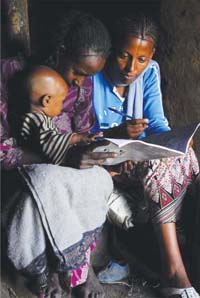
In message development, there are two components that you should consider — the content of the message, and the process by which you plan to convey the message. You will have to think about the content of the session, the topics that you want to cover during the session, and if there are any specific facts that you want to deal with. You should also think about the process you will use. You should think about whether there are any activities that will help you deliver your message, and you should be organised and prepared if there are any forms or other materials that need to be handed out during the session.
15.1.1 Learning objectives
In all your health education work, you will need to decide what it is that you want your audience to have learnt by the end of the session (i.e. learning objectives). The learning objectives you are aiming to achieve during your session determine the nature of the message you need to develop. For example, in order to improve people’s knowledge, giving them facts and clear information is important. However, to influence your audience’s attitudes about health issues, the facts by themselves will not be sufficient. To improve health-related skills in your audience, specific training and giving clear instructions on how to behave is especially important.
What would a suitable learning objective be if you were teaching a session to a group of mothers on how to prepare re-hydration fluids if their children became dehydrated?
At the end of the session, your audience should all be able to explain to you how to prepare suitable fluids to feed their babies if they became dehydrated in the future.
15.1.2 Suitability of the method
Some health education methods are better than others when attempting to deliver a particular kind of message. For example, simple facts about specific health issues may be best delivered through a lecture. Skills are best developed through giving the audience a chance to practise, and by giving them demonstrations and simulations. Drama and role play may be good to influence the attitudes of your audience.
Think of an important health issue in your own community. What learning objectives do you think might be appropriate to get across your health message? What methods do you think might be best to deliver health messages about this subject to members of your own community?
Your answer might be different depending on your learning objectives. For instance, if your learning objective is to improve a skill, then a practical demonstration is good. If your objective is to improve awareness, then group discussions may be a good method.
The example of Makeda (below) shows how one health worker tackled this message: ‘Using bed nets will help prevent malaria.’
Makeda, who is a Health Extension Practitioner, wants the people in her village to understand the importance of using bed nets. The learning objective is: ‘To help the people in the village become aware of why using bed nets is important. The message is: ‘Using bed nets will help prevent malaria’.
The best method in this case will be a small group discussion, and demonstration in one of the village houses.
15.1.3 Available resources
You should also make sure that all the necessary resources are available to deliver the message (Figure 15.2). For example, if you want to deliver your message using the demonstration method, you may need additional resources.
If your message is about the proper use of insecticide-treated bed nets, do you think a lecture or a demonstration would be better? And if the latter, what resources would you need?
Using bed nets is a practical activity, and not just a piece of knowledge. You can easily show people how to do it if you have the right resources. For instance, you need some bed nets, sticks, ropes, and some individuals who can assist you, as well as an appropriate space to conduct the demonstration.

15.1.4 Characteristics and preferences of the audience
To decide the kind of appeal you should use in health education, always take into account the characteristics of the audience. For example, some communities may be influenced by positive appeals, others may be influenced by emotional appeals. It helps to prepare a message that is tailored to the need of your audience.
All health education messages should be culturally sensitive, and consider the comprehension level of the audience. For example, locally offensive words should not be used. Technical words should also not be used. Using complicated medical terms will not be understood by the people you are trying to reach. For example, if you tell people ‘Mycobacterium tuberculosis causes TB’, they may not understand what you are telling them.
Which of the following should you avoid when developing your messages?
- Local terms which people understand
- Technical words
- Locally offensive words
- Complicated medical terms
- Simple accessible terms.
Your terms need to be local and simple. Avoid medical and technical terms, and certainly avoid any words which might give offence to your audience. Choose words suited to the age of the audience (Figure 15.3).
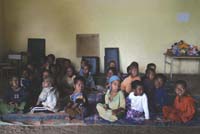
15.2 Dissemination of health messages
Ideally, all health education messages should be pre-tested before being used more widely. Pre-testing is testing the message with representatives of your target audience before the message is disseminated to a wider audience. Without pre-testing, a message stands the chance of becoming ineffective and detached from the needs of the target audience. You may not need to conduct large scale pre-testing. For example, when you teach mothers about family planning at your health post, you can ask them how well they understood your message, their reactions, and how comfortable they are with your methods. In your future health education activities, you will be able to modify your approach as a result of getting this feedback.
Once your health education message has been developed, the next step is to disseminate the message to the respective audiences that you are trying to reach. Dissemination means conveying or delivering the message to each audience at a variety of different places. This is the actual implementation of your health education activities. However, you should keep in mind that health education is more than the simple dissemination of health education messages.
In order to bring about behavioural change, dissemination of your message should be accompanied by other supportive activities which facilitate the behaviour change process. For example, you need to clarify misunderstandings, elaborate the content of the message with examples, and identify barriers that may prevent people from performing the beneficial behaviours. This may also involve providing the resources needed to perform the health-related behaviour, such as providing condoms or other contraceptive methods if your message is about contraception. It may also be necessary to address any cultural factors which discourage the desired behaviour.
In Ethiopia, most mothers do not exclusively breastfeed for the first months. There may be various reasons for this unhealthy practice:
- Mothers may not understand the benefits and the exact period that is best for exclusive breastfeeding (Figure 15.4).
- Husbands and grandmothers may prefer to start additional food too early.
- Community leaders may not understand why it is important to support exclusive breastfeeding for the first months of the baby’s life.
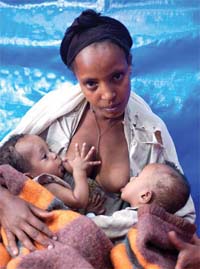
Think about what kind of messages and supportive activities you could undertake in order to promote exclusive breastfeeding. To help you do this, think particularly about whether you would give the same message to the mothers, the husbands and grandmothers, and the community leaders.
Of course, you may not have thought about this before, and only have a couple of ideas. Table 15.1 provides a fairly full answer, and gives you an idea of the way that an experienced Health Extension Practitioner might tackle this issue.
| Audience | Message |
|---|---|
| Mother | Breastfeeding is a proof of your love. Take good care of your child from birth. Give your child breastmilk so the child will grow well and be strong. Breastmilk is the only food that a child needs to protect him/her in his/her first six months. |
| Husband and grandmother | Help mothers practise exclusive breastfeeding so your children and grandchildren will grow up to be healthy, strong and intelligent. |
| Community leaders | Promote exclusive breastfeeding for the first months. Advocate this behaviour and encourage the mothers. |
| Reinforce the message at every contact with the mother | Provide breastfeeding counselling and support during antenatal care, delivery, and immediately postpartum, as well as during postnatal, family planning and immunization sessions. Your health education activities should clarify misunderstandings, and you can always elaborate the content of the message with examples. Your work should identify barriers and help mothers to overcome these barriers. |
15.3 Recording health education activities
Recording and reporting all your health education activities is very important, and you must record all your routine health education activities according to the standard documentation guidelines provided for you (Figure 15.5). It is usually considered that an activity which is not recorded has not been done. So, if you fail to document or record the activities you have accomplished, others will not know whether or not the activity has been performed.
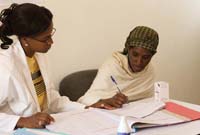
Likewise, if you fail to record activities, you cannot evaluate and monitor your achievements. As well as recording the activities, you should also report your health education activities to the concerned bodies, like the local health centres, and the woreda health office. You should keep others informed about the progress of your activities so that they can give you any necessary support and help. Health education activities are usually reported in standard reporting format. If standard reporting format is not available to you, you can record the activities in your own registration book, and later you should be able to replace it with the standard reporting format, when it is made available for you to.
Look carefully at Box 15.1. It describes health education activities which should be recorded.
Box 15.1 Recording health education activities
During the implementation of a health education activity, the following information should be recorded:
- Number of people who received health education (total, male, females)
- The topic addressed, and the content of the message
- The place where the health education activity was delivered
- The person who delivered the health education session
- The materials used (posters, leaflets, etc.)
- The method used (discussion, drama, etc.)
- Number of households reached or covered
- Number of health education sessions delivered
- Were any problems encountered?
Mrs Chaltu is a Health Extension Practitioner. She is working in Maru kebele. She conducts home visits three times per week. During her home visits, she educates the families that she visits about family planning and how to prevent communicable diseases. Using Box 15.1 above to help you structure your answer, write down how Mrs Chaltu should record her health education activities.
Ideally, she should record all the health education activities she has undertaken for example, the number of households visited, the number of people given health education at home, the methods and materials used, the messages disseminated, the number of mothers receiving health education on family planning and communicable diseases, and any other details of problems that have arisen.
Recording the problems you have come across is such an important thing to do. Solving problems is one of the key ways we all learn, and so if you note your problems and what you did about them, you are also recording your own learning!
15.4 Monitoring the implementation of health education activities
While you are undertaking health education activities, make sure that the planned activities are actually delivered in the way that they have been planned. It is easy to begin with plans and then to go off the beaten track. The method which enables you to know whether the activities are being implemented as planned is called monitoring. Monitoring is the ongoing routine collection and analysis of information that you record as your activities are progressing. Using monitoring, you should be able to check whether activities are being carried out as planned, and whether they are effective or not. Monitoring will help you keep your work on track, and can let you know when things are going wrong. If things are going wrong, you will be able to take action to correct any problems. Monitoring should enable you to determine whether the resources you have are sufficient and are being well used —and whether the capacity you have is sufficient and appropriate.
Monitoring can take place at any time during the implementation process, on a regular or periodic basis. For instance, you will be able to monitor your activities daily, fortnightly or monthly, or as the need arises. So as you can see, monitoring is absolutely crucial.
15.4.1 Monitoring health education activities
The data which shows the progress of health education activities can be collected by several methods, from various sources (Figure 15.6). During all your health education work, you will be able to observe how your own activities are being received, and the reaction of the community or participants. Of course, you will make periodic visits to households, during which time you can check whether their health-related practice has actually changed. It is important to make a periodic review of your recorded activities. For example, fortnightly you can review your achievements and check whether you have completed what you have planned to do. Feedback from clients and community, particularly those who participated in the activities, will always be the most important sort of monitoring.
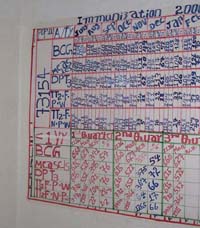
15.4.2 Input monitoring
Input refers to all the resources required to carry out your health education activities. It includes labour force, finances, materials, space and time — all of which should be recorded. Input monitoring involves checking whether the various resources required in order to carry out health education activities are in place, and whether they are going into the intended activities.
15.4.3 Output monitoring
Output is the achievement obtained through utilising resources. It is the extent to which you have delivered the planned services, for example the number of people who have received your health education messages. Output monitoring involves checking whether the resources that you have utilised for your health education activities have brought about the desired results (Figure 15.7).
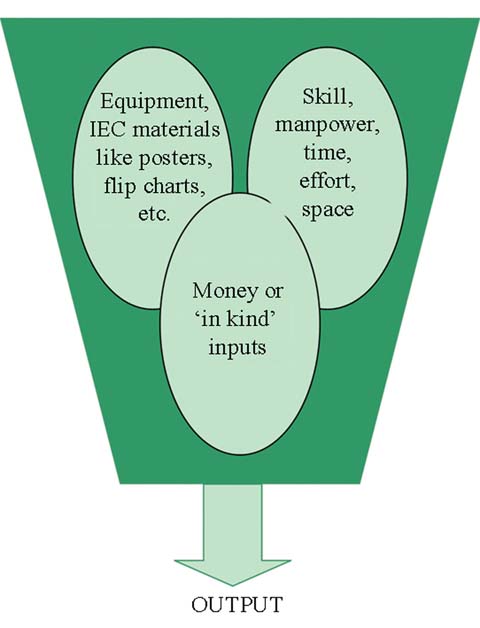
15.4.4 Process monitoring
Process monitoring tells you if you are doing the right thing to achieve your objectives, for example whether you have selected appropriate health education methods, topics, contents, messages, and so on. If you are not doing the right thing, then process monitoring will help you take corrective measures. For example, if the participants are not comfortable with your method, or with the content of your message, you will be able to make adjustments according to their needs and interests.
Ms Tejitu has planned health education activities on HIV/AIDS to deliver to adolescents at her local school. She carried out her plan and has used the following indicators to monitor her activities. Identify the type of monitoring in each of the following statements and give a reason for each answer.
- a.She checked whether the health education materials which she was going to use for her demonstration were readily available.
- b.She also checked whether her health education methods were appropriate, and whether they were applied properly.
- c.She checked whether the expected number of students had attended the health education sessions
The types of monitoring are:
- a.is input monitoring, because it involves checking whether the resources she needed to execute her health education activities were available.
- b.is process monitoring, because it involves checking whether she was doing the right thing. In effect, she was overseeing whether her activities are being implemented in the right way.
- c.is output monitoring, because it involves checking whether she has delivered health education for the expected number of adolescent young people at the school.
Summary of Study Session 15
In Study Session 15, you have learned that:
- Health education messages can be facts, information, ideas, opinions, or a course of action that you convey to influence individual or community behaviours.
- You should always develop your messages in advance of conducting any of your health education sessions. When you develop your health messages, you should keep in mind the learning objectives, the available resources, and the characteristics of your audience — and then select the most effective health education methods to use.
- Different messages are needed to influence different target groups, and you must prepare a message which is tailored to each specific target group.
- Once the message is developed, the next step involves disseminating the message to the respective audiences that you have chosen. However, health education is much more than dissemination of the message. It should be supported with a wide range of other supportive activities.
- Recording health education activities is one of the most important tasks for Health Extension Practitioners. All your health education activities should be recorded and reported using standard documentation and reporting formats.
- Monitoring is the systematic collection and analysis of data on work performance. It will help you to check whether activities have been undertaken as you planned. Monitoring will help you keep your activities on track.
- In health education, input, output and process should each be monitored. Input monitoring deals with the resources required to run health education activities. Output monitoring deals with checking whether your expected health education activities have been delivered as planned. Process monitoring checks whether you are doing the right activity that will help you to achieve your learning objectives.
Self-Assessment Questions (SAQs) for Study Session 15
Now that you have completed this study session, you can assess how well you have achieved its Learning Outcomes by answering these questions. Write your answers in your Study Diary and discuss them with your Tutor at the next Study Support Meeting. You can check your answers with the notes on the Self-Assessment Questions at the end of this Module.
SAQ 15.1 (tests Learning Outcomes 15.1 and 15.2)
Tirunesh is working in a small village called Shoro. Malaria is a common health problem in the village. The village people believe that malaria is caused by a bad sprit and that it is a self-limiting disease. They do not allow the sick person to take any drugs, because they believe that if the sick person takes the drug, it makes the disease worse. Moreover, there is a belief that no one who gets sick from malaria should go to another place to seek treatment, because they believe that malaria becomes worse if the sick person leaves their dwelling area.
To change these beliefs Tirunesh has planned certain health education activities, and she wants to consult with you on how to develop the most effective health education messages.
- a.When should she prepare the health messages that she is going to deliver? Why?
- b.What should be the content of her messages?
- c.What consideration should she take into account when preparing her messages?
- d.List the sort of health education activities that she should record.
- e.Why is it important for her to record all of her health education activities?
Answer
- a.She should prepare her message about malaria prevention prior to her health education session. A message prepared during the learning session itself may not be in line with the learning objectives, and has little impact on behaviour change.
- b.She should determine what topic and content needs to be taught, as well as the arrangement of the message, questions to be incorporated, and activities to be accomplished, message forms, and so on.
- c.When preparing her message, she should take into account the learning objectives, methods, resources, audience, culture and comprehension level of the audience.
- d.She should record health education activities like the number of people who received health education, the topic, the place where health education was delivered, the method and materials being used, the number of households reached, the number of health education sessions, and any problems encountered.
- e.Recording all of her health education activities is very important to monitor the progress of her sessions, and to evaluate her performance and achievements, as well as to tell others what she has done, and to prepare reports for concerned bodies, and so on. You should note that others may consider an unrecorded activity not to have been done.
SAQ 15.2 (tests Learning Outcomes 15.3, 15.4 and 15.5)
Chaltu is a Health Extension Practitioner. She is working in a village called Goro. One day she planned to conduct a health education session on the proper use of insecticide-treated mosquito nets (ITNs) to reduce the incidence of malaria in her village. She planned to demonstrate the proper use of bed nets. In her demonstration, she used bed nets, sticks, tacks and rope. Before she started the demonstration, she checked whether all the necessary resources to carry out the demonstration were in place. Two other people assisted her during the demonstration, and 20 people participated in that health education session. She explained each step to them on how they should use the net properly. Based on this information, answer the following questions.
- a.Identify the inputs Chaltu has used to conduct this health education session.
- b.What is the output that Chaltu has achieved?
- c.Identify the type of monitoring Chaltu has undertaken.
- d.What activities should Chaltu undertake in order to monitor the process of her health education session?
- e.What achievements should Chaltu record about her health education session?
- f.What activities should Chaltu report to concerned bodies?
- g.Why is it important for Chaltu to monitor all of her health education sessions?
Answer
- a.Bed net, sticks, tacks, rope, two helpers, and Chaltu herself.
- b.The number of people who received health education (20 people).
- c.She conducted input monitoring. She checked whether the resources required to carry out the demonstration were in place.
- d.To monitor the process of the health education session, she could check the process of the demonstration, e.g. whether the bed net was properly demonstrated, whether steps were clearly explained for the participants, whether the message was correctly delivered, and so on.
- e.After the health education session, she should record and prepare a report. In her report, she should include the number of people who received health education, the message, the method, the materials, the problems encountered, and so on.
- f.Monitoring is the ongoing routine collection and analysis of information as activities are progressing. In monitoring, she checks whether activities are being carried out as planned.
- g.Monitoring helps her in several ways. It helps to keep the work on track, it can let you know when things are going wrong, it enables her to determine whether the resources she has are sufficient and are being well used, and to know whether she is doing what she planned to do.
SAQ 15.3 (tests Learning Outcome 15.5)
Match the type of monitoring to the indicators by rearranging the items below.
Two lists follow, match one item from the first with one item from the second. Each item can only be matched once. There are 3 items in each list.
Checking whether the resources needed to carry out health education are in place
Checking whether health education methods are used properly
The number of households reached during the health education sessions
Match each of the previous list items with an item from the following list:
a.Input monitoring
b.Process monitoring
c.Output monitoring
- 1 = a,
- 2 = b,
- 3 = c